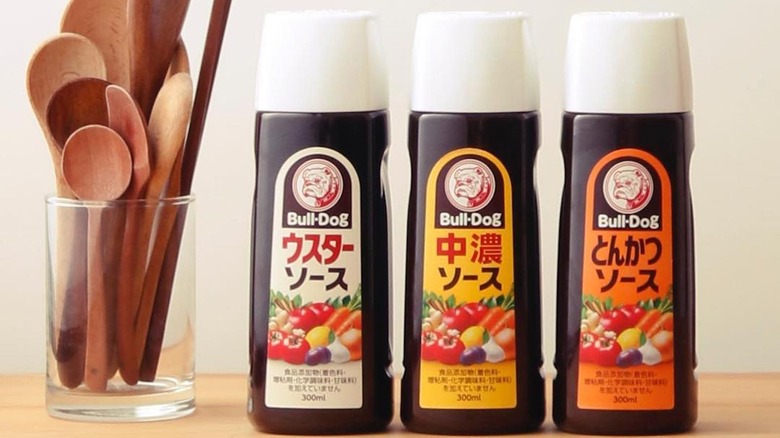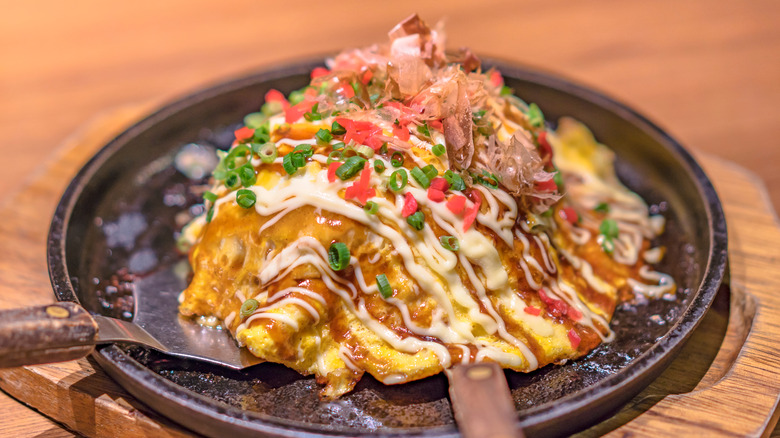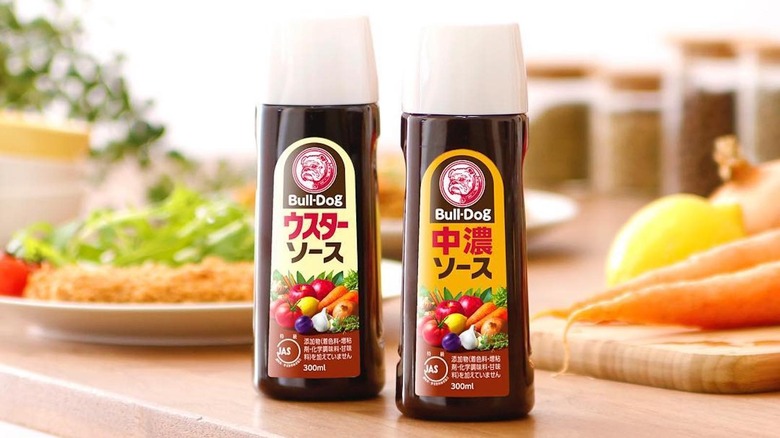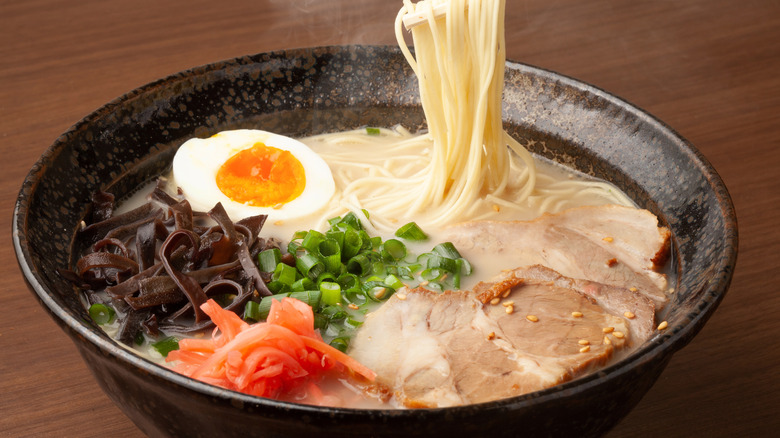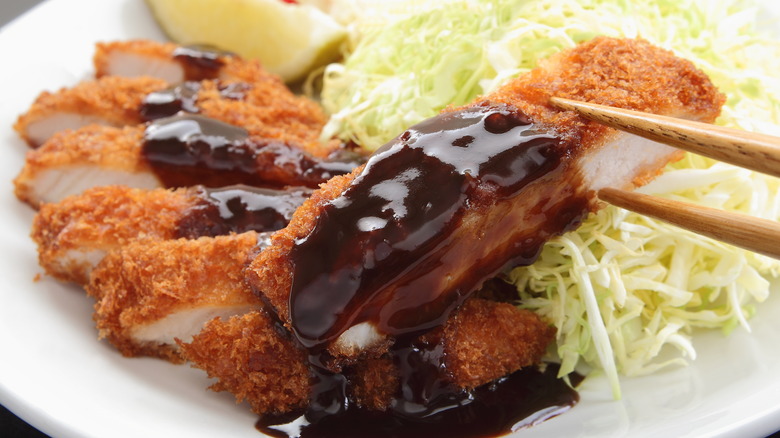The Untold Truth Of Bull-Dog Sauce
Bull-Dog sauce is synonymous with the name Tokyo Tonkatsu, to the point where some foodie fans don't even realize there are actually different types of tonkatsu sauce. Much as Huy Fong Foods is known as the makers of Sriracha, Bull-Dog is often the gold standard in this condiment division. Rather than a condiment, Bull-Dog sauce was originally meant to be used as a sauce when it was created in Japan in 1902, and it was specifically developed to appeal to the Worcestershire-loving palate (via Tokyo Tonkatsu). It was this English inspiration (the home of Worcestershire) that led to Bull-Dog being named after the beloved pet. Today, it is known worldwide and adopted by many as a Japanese cultural trademark.
The sauce itself has a consistency that resembles many types of barbecue sauce, a product that also looks similar in color. This condiment is known for its distinctive yet versatile flavor, as one reviewer describes it: "Bull-Dog is a sweet sour sauce that is used on fried breaded cutlets. The sauce has a strong tamarind flavor. I use it as a dipping sauce for tofu balls, a croquette made of tofu, rice, and peanut butter" (via Amazon).
How do you use Bull-Dog sauce?
If you are new to the condiment, your first stop in using tonkatsu will probably be pork tonkatsu. This pork dish is typically made with a breaded and fried pork cutlet, served alongside shredded cabbage, or with miso soup and rice (via The Daily Meal). However it begins, this classic dish ends with a generous drizzling of tonkatsu sauce before serving. Many of you may have tried a similar dish called chicken katsu, which is made along the same lines and often using the same sauce, according to Food and Wine. The result is a combination of savory, sour, and a little sweet atop a crispy, salty cut of meat. If chicken nuggets grew up, they'd become tonkatsu dishes.
Another popular version of this dish includes slicing the pork cutlet and serving it with a giant egg pancake (via The Wok Life). The egg mixture will typically contain onions, maybe some additional seasonings, and maybe be slightly sweet based on ingredient choices. No matter what the final mix, the egg should be a layer in and of itself to add richness, filling, and flavor to the mix. Alternatively, there is an entire savory pancake dish version called okonomiyaki that is also popular. Other less traditional uses include using tonkatsu in place of Worcestershire sauce in meals or mixing it with ketchup to make a seasoning or sauce for almost anything you want to dip or baste, as one Redditor described.
The Bull-Dog appeal has attracted investors
Bull-Dog tonkatsu almost got acquired by American investors back in 2007. While the brand has global appeal, this company is widely recognized as a product (and flavor) of Japan. What happened involved a failed American takeover of the sauce that would leave an American hedge fund with significantly reduced shareholder power and created a loss of a billion yen for the company in 2008, according to Forbes.
American fund Steel Partners had owned the largest consolidated share of Bull-Dog's parent Tokyo Tonkatsu at just over 10% and attempted to initiate a takeover purchase of the company. This process was so contentious that when a Japanese lower court made a ruling to block the bid, they called the group "vulture investors." The Japanese Supreme Court agreed and sided with the sauce giant's anti-takeover measures — helping to keep Japanese tonkatsu more authentically Japanese. As Forbes notes, the Bull-Dog legal battle was "watched closely by foreign investors seeking to gauge Japanese receptivity toward foreign takeovers."
Bull-Dog is more than tonkatsu
And while we always think tonkatsu when we hear Bull-Dog, in fact, this is only one of the company's sauce product offerings. Most common are the Vegetable and Fruit Sauces as well as the Worcestershire. The Worcestershire is described as spicy with hints of fruit and umami, according to Japanese Taste. Fans will know this sauce is a little runnier than the more ketchup-like companions. Next come the Vegetable and Fruit semi-sweet and tonkatsu. The semi-sweet is listed as "spiciness and mildness to the umami of vegetables and fruits" and described as a great secret ingredient or drizzle. Third in these top-sellers is the more viscous tonkatsu, richer but with the same umami and fruit and veggie flavors. This is the most condiment-style of the above.
There are additional varieties of the sauce that may be more difficult for American foodies to find, but one example is the sesame tonkatsu. The addition of the sesame is said to "make the sauce more mild and sweet," per Japanese Taste.
Tonkotsu vs. Tonkatsu
A common mistake fans will make when exploring this ingredient is confusing tonkotsu with tonkatsu. Trust us, the difference matters, although if you get it wrong it's likely to be a happy little accident. Tonkotsu generally translates to "pork bone" and, in this case, that means pork bone broth (via Ejji Ramen). Cooks will simmer this broth created from the pork bone and marrow for about eight to 12 hours. The broth is then traditionally served with thin ramen noodles (not your packaged dollar kind) and additional toppings that may include soft-cooked egg, beef or pork, green onions or scallions, and in some cases, pickled ginger or various seaweeds. Additional ramen favorites may include pork belly, char siu pulled pork, and an organic miso egg.
While not all ramen is tonkotsu, almost all tonkotsu will be ramen. To differentiate, tonkatsu will typically refer to the fried and breaded pork or may refer to tonkatsu sauce — the delicious condiment from Bull-Dog and other vendors.
Defining authentic tonkatsu
Redditor MyNameisLuna asks the question many home cooks have wondered about: "I'm not sure if Tonkatsu sauce is the same as Katsu sauce, and if there is any sort of squirty bottle of Katsu sauce I could pick up much like tomato ketchup," (via Reddit). In reply, user KaneHau explains, "Tonkatsu sause is Katsu sauce. There are many 'types' (with various ingredients)."
The ingredients for Bull-Dog sauce in the United States include standards like high fructose corn syrup, sugar, water, and distilled vinegar, according to the label listed on Amazon. There's also some salt and starch plus a tomato paste base. The more unique ingredients include hydrolyzed vegetable protein (containing soy), apple puree, prune paste, carrots, onions, and lemon juice as well as yeast and unnamed spices. These ingredients make it clear how the fruit and vegetables are part of the mix.
Other types of tonkatsu will have slight variations, like homemade varieties. While often very good, you'll be able to tell the difference. One quick fix if the store runs out of your favorite is to combine ketchup, Worcestershire sauce, oyster sauce, and sugar, per Just One Cookbook.
